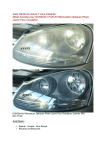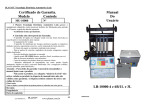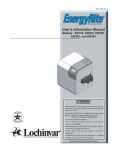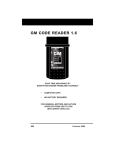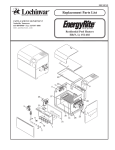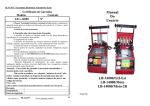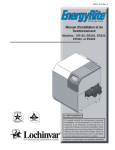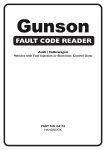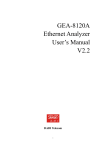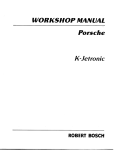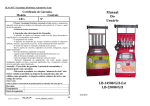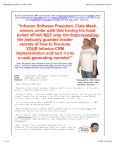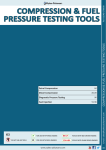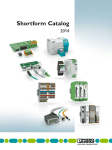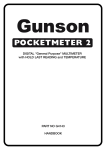Download FAULT CODE READER
Transcript
FAULT CODE READER FORD PART NO G4160/4152 HANDBOOK Gunson Fault Code Reader 2 Gunson Fault Code Reader Fault Code Reader FORD Vehicles with EEC IV Electronic Control Unit (3 pin) Plus early vehicles with 5pin diagnostic connector INDEX Contents Page 1. Applications 4 2. Safety first 5 3. How fault codes make it easy 6 4. Introduction 8 5. How to use the Fault Code Reader 8 6. Instructions 10 7. Model specific data sheets 14 8. Fault Codes 15 9. Test Procedure Notes (TPN) 22 10. Common Terms 27 11. Warranty 30 3 Gunson Fault Code Reader 1. Application list Part No Type Vehicle Application Engine Type G4160 Five Pin Escort/Orion 1.6 CVH with KE Jetronic EFi with Catalyst 86-90 Granada/Scorpio 2.0 OHC EFi (non catalyst) 2.4 V6 EFi (non catalyst) 2.8 V6 EFi 1986 2.9 V6 EFi (Non catalyst) Sierra/Saphire 2.0 OHC EFi (non catalyst) 2.8 V6 EFi 1986 2.9 V6 EFi(non catalyst) G4152 Escort/Orion/Mondeo Cosworth 2.0 with Weber Marelli Injection System 1.6/1.8/2.0 Zeta engine Up to 1995 Transit 2.9 V6 EFi(non catalyst) 3 Pin Fiesta, Escort, Orion Sierra, Sapphire, Granada, Scorpio 1.1/1.3 CVH CFi 1.3 HCS CFi 1.4 CVH CFi 1.6 CVH CFi &EFi 1.6 CVH EFi TURBO(not KE jetronic) 1.8 CVH CFi 2.0 OHC EFi Catalyst only 2.0 DOHC 2.4 V6 catalyst 2.9 V6 catalyst and V6 24v catalyst 1984/1986-95 Escort/Orion/Mondeo 1.6/1.8/2.0 Zeta engine Upto 1995 Vehicle ApplicationTransit 2.0 OHC CFI 1986< 2.0 OHC EFi 1992< 2.9 V6 EFi 1992< Part No G4160 Five Pin (early version) Ford 5-way diagnostic socket Part No G4152 Three Pin Ford diagnostic socket with removable red cover 4 Gunson Fault Code Reader 2. SAFETY FIRST General safety guidelines to follow when working on vehicles • Always operate the vehicle in a well ventilated area. • Do not inhale exhaust gases - they are very poisonous. • Always make sure the vehicle is in park (Automatic transmission) or neutral (manual transmission) and that the parking brake is firmly set. Block the drive wheels. • Always keep yourself, tools and test equipment away from all moving or hot engine parts. Treat high tension ignition components with respect, remembering that electrical shocks can cause involuntary movement which may result in secondary injury. • Wear approved eye protection. • Never wear loose clothing that can catch in moving engine parts and always tie-up or cover long hair. • Never lay tools on a vehicle battery. You may short the terminals together causing harm to yourself, the tools or the battery. • When carrying out tests on a motor vehicle, remember NEVER run the engine with the car battery disconnected (either + or -) since the alternator would then run at a damaging over-voltage. • Never smoke or have open flames near vehicle. Vapours from gasoline and charging battery are highly flammable and explosive. Always keep a suitable fire extinguisher handy. • Never leave vehicle unattended while running tests. • Keep children and animals out of the area. • Always turn ignition key OFF when connecting or disconnecting electrical components, unless otherwise instructed. • Always follow vehicle manufacturer's warnings, cautions and service procedures. CAUTION Some vehicles are equipped with safety air bags. You must follow vehicle service manual cautions when working around the air bag components or wiring. If the cautions are not followed, the air bag may open up unexpectedly, resulting in personal injury. Note:The air bag may still open up several minutes after the ignition key is off (or even if the vehicle battery is disconnected) because of a special energy reserve module. 5 Gunson Fault Code Reader Precautions to be followed when using the Fault Code Reader • Before connecting the leads, ensure that the correct connector of the car has been identified. • Using this product may cause vehicle systems to self test, items such as coolant fans to suddenly start with no warning, and engine speed to suddenly increase. • Using this product can involve working on a car while the engine is running. This is a potential hazard and the user should take every precaution to avoid any possibility of damage or injury. 3. HOW FAULT CODES MAKE IT EASY Modern vehicles have electronic control units that are able to identify and remember faults which occur in the vehicle's equipment. This system was introduced on the higher specification electronic fuel injection vehicles around 1986 and was applied to other types of ECU a little later(ABS and Ignition) Its application is now virtually universal to all petrol engine vehicles. This is a great benefit to service and maintenance personnel as it can considerably simplify vehicle repair. The vehicle faults are stored in the vehicle's Electronic Control Unit (ECU) as "Fault Codes". The system is so simple that retrieving vehicle fault codes does not require particular skill. However, in order to read these fault codes some equipment is necessary. (E.g. a Fault Code Reader), which is used to instruct the vehicle's ECU to download fault codes and/or present them to the user on a display. By far the most common system is to present the code as a “blink code”. The Fault Code Reader will activate that part of the OBD programme which identifies the defective component and cause a code to be displayed, usually by a light on the Fault Code Reader or by an instrument panel "Check Engine" light. These provide a series of pulses to simply count a code number. Systems with an instrument panel “Check engine” light are able to illuminate this when the engine is running to warn of faults, other systems are more secretive and need to be interrogated. The Fault Code Reader is an economical but very effective product. It is available for a wide range of vehicles and enables the user to instruct the vehicle to download stored fault codes. Having obtained the fault codes, the user then identifies the nature of faults by referring to a list of code numbers. Comprehensive lists of code numbers are included in this handbook. 6 Gunson Fault Code Reader NB Car manufacturers have in the past used a connector type unique to their own cars. Many manufacturers have used different types of connector at various times. Only recently have there been moves to standardise to a 16 pin socket. Makes and models of car also vary in the degree of testing and fault diagnosis that is possible. In general, the ECU will identify faults that exist at the time of the test, but the ECU may also have a memory that remembers faults that have occurred in the recent past, and these can also be read out from memory using the Fault Code Reader. For instance, in some vehicles, the readout consists of the faults that are present at that time, followed after a “separator” code, by the codes that are held in memory from some previous time. In most vehicles, tests are carried out with the engine off (but ignition on). Occasionally additional tests may be carried out with the engine running (this depends on the sophistication of the ECU and is not available on all makes of vehicle). Having identified the fault codes, and eliminated the faults, the user may then wish to erase the faults from the ECU's memory.With some cars this is possible using a special sequence of operations, or a sequence of switch operations on the Fault Code Reader. With other vehicles this is not possible and it may be necessary to erase the memory by disconnecting the battery (-) connection (with engine not running), this has the disadvantage that codes for radio/ security system and also some ECU memory settings are temporarily lost. Fault codes generally disappear anyway after the fault has not been present for a certain number of engine start cycles, but deletion of the codes followed by a short drive has the advantage that it allows the operator to check if the fault has truly been rectified. This is confirmed if the code does not re-occur. Before using this product (or indeed carrying out any vehicle maintenance), the user is recommended to read the precautions presented in later sections of this manual. In particular, note that during the use of this product the vehicle's On Board Diagnostic programme (OBD) takes control of the vehicle, and may activate various vehicle systems (such as turning on the cooling fan), this can constitute a safety hazard and the user should keep fingers clear during tests. 7 Gunson Fault Code Reader 4. INTRODUCTION This product is suitable for use only on Ford cards which have the EECIV Engine control unit (ECU). This ECU is very widely used on Ford vehicles. It was introduced in 1985, was universal on EFi engines from 1988/89 and became virtually universal on all petrol engined Ford cars from 1991/92. Ford EECIV is a generic system and there are several variants. Early EECIV used a 2 digit code system, and there are 2 different 2-digit code systems. Later EECIV used a 3 digit code and there is a variant of this Fault Code Reader with the correct socket to suit these vehicles. (Three way triangular socket with three contacts). NB:After late 1995/early 1996 a 16 pin diagnostic socket may be fitted to some engine variants (EEC V ECU) and a blink code system is no longer used. Full instructions to help you use the product and interpret the information are included and should be read carefully Moving the Test Switch (labelled 0 and I) from 0 to I starts a test or changes the way the vehicle’s Electronic Control Unit (ECU) functions. The LED code indicator. will transmit pulses which represent the fault codes. 5. HOW TO USE YOUR FAULT CODE READER NUMBER / CODE IDENTIFICATION Identifying fault codes is in fact very easy and simple, though it may seem complicated at a first reading, the user will soon get accustomed to the technique. Basically, the ECU communicates with the “Code Reader” in a series of pulses, and the user simply counts these pulses to identify particular numbers. For example, the number 6 would be transmitted as 6 pulses in rapid succession. If we use the symbol R to indicate a pulse, then the number 6 will be transmitted as: R R R R R R = 6 If the number is a 2 digit number, then each digit is transmitted separately. For 8 Gunson Fault Code Reader example, the number 25 would be represented as 2 pulses, followed by a brief pause, and then 5 more pulses. R 2 R R R R 5 R R = 25 In practice, the ”Fault Code Reader” code will be output as a series of numbers one after the other, and the user has to recognise individual numbers, and recognise the gaps between numbers. This is made easy by the fact that the pause between two numbers is much greater than the pause between the individual digits of a number. Similarly, there is an even greater pause between one series of code numbers (egg representing current faults), and another series of code numbers (e.g. representing faults stored in memory. To make matters even easier, the ECU, in most instances, repeats a series of code numbers, so that the user has the opportunity to check the reading. Each code has a particular meaning, which is identified by reference to the tables of Fault Codes which follow. GENERAL NOTES Before connecting “the Fault Code Reader” to the car, the user should ensure that the TEST SWITCH is set to "O" and the diagnostic socket has been correctly identified. Check that the car ignition is off, the car is out of gear, and that the handbrake is applied. When a fault code appears, it does not necessarily mean that the component indicated is faulty. It could mean that the ECU has received a signal from the component or it's wiring, which is outside specification. Therefore before tests are performed, (using the Test Procedure Notes later in this Manual), it is important all of the connections and wiring associated with the indicated component are checked. When multiple faults are indicated, it is possible that the fault on one component is causing incorrect readings from other components, but all the components will have to be checked to eliminate the true cause. 9 Gunson Fault Code Reader 6. INSTRUCTIONS Refer to the Tables in Section 5 to confirm whether the vehicle has a 2 or 3 digit code. Initial Procedure Before connecting the Fault Code Reader, carry out a basic inspection under the bonnet to ensure all leads and connectors are secure and that the breather system is operational. Turn off the ignition Disconnect any octane and idle adjust service wires if these have been connected to ground. This connector is usually coloured white and is illustrated in Fig 3. If this connector is connected to ground, then the test will proceed but Fault Code 53/54 may be recorded. Ensure that the Fault Code Reader switch is in the O position. Connect the FCR to the diagnostic socket (usually found near the engine bulkhead or the battery) FCR connection: Brown to A Green/Yellow to B Blue to C A number of different test procedures are now possible: IGNITION ON – ENGINE OFF TESTS Turn the ignition but do not start the engine Put the Test Switch into the I position. Wait for approximately 10 seconds and ignore any rapid pulses. (This is the on-board diagnostics (0BD) computer carrying out its initial tests). During this period the user may notice things happening under the control of the OBD system. Eg The coolant fan may momentarily start. The OBD will then begin to output a sequence of codes which will be observed as a pulsing of the LED indicator on the FCR. It will first transmit codes for faults that are currently present and after a short delay these codes will be repeated. A separator code may then be transmitted (the number 2) followed by the outputting of codes stored in 10 Gunson Fault Code Reader keep-alive memory (KAM). These KAM codes will be repeated. Then there will be a further delay followed by the digit 1 – this signifies that this test is ended and that the OBD is now waiting for the start of the Wiggle Test NB:The majority of vehicles using the Ford five way socket do not have KAM and Wiggle Test facilities. See the full application table in Section 5 WIGGLE TEST Follow the test procedure as for Ignition On Engine Off. After the KAM codes are transmitted a single separator pulse will follow. This single digit indicated that the Engine Off test is complete and that the Wiggle Test is now activated. The purpose of the Wiggle Test is to enable the testing of all connections and wiring to the main sensors (Eg air-flow meter, throttle position, air temperature, coolant temperature etc.) If a connector to a sensor is wiggled and a bad connection exists then the LED will pulse for as long as the connection remains bad. Subsequent readout of th KAM codes will show which sensor had the connector fault. NB: Setting the Test Switch to O during the Wiggle Test will erase fault codes stored in KAM ENGINE RUNNING TEST Ensure the engine is fully warmed up (and the air conditioning, if fitted, is switched off) and that the ignition is switched OFF. If the engine is not fully warmed up then when the test is started there will be a delay until the ECU detects that the engine has reached operating temperature. Connect the FCR and set the Test switch to O Switch on the ignition and start the engine. The engine should be started within 10 seconds after the ignition has been switched on otherwise the Engine Off tests will begin. (Some models require only a 3 second delay before Engine Off tests begin) The vehicle’s OBD procedure will now commence. Ignore any rapid pulses on the FCR as this is the OBD carrying out its initial tests. With some vehicles 11 Gunson Fault Code Reader Code 5 will be output to indicate that the engine running test has started. The engine speed will increase to about 2500rpm and after about 10 – 60 seconds the engine speed will return to normal. The FCR will then transmit a single pulse (Code 1). This is the DYNAMIC RESPONSE signal and indicates that some action is required from the user. In this case, the required response is to depress the throttle fully and release. The ECU will then transmit the Engine Running test codes and after a short delay these will be repeated. After a further delay six pulses may be transmitted (Code 6) Therefore if there are no engine running faults the transmitted output codes will be as follows: 11 11 6 Code 6 indicates that the engine running tests are complete and the OBD is in SERVICE MODE where it will remain for about 2 minutes (See Service Mode). If Code 5 was transmitted earlier then Code 7 will be transmitted to indicate the end of Service Mode. NB Single digit codes (Eg Codes 1 5 6 7) may be referred to in Ford documentation as Codes 10 50 60 70 SERVICE MODE Service mode follows on from Engine On tests. During Service Mode the idle speed and ignition are controlled by the ECU and it is during the Service Mode that the basic settings can be checked and reset by the user if required. Such adjustment cannot be made at other times as they would be overruled by the engine ECU. Refer to Section 5 for Service Mode data) Service Mode is engaged for several minutes after Engine Running test (2-10minutes depending on the engine model) The end of the Service Mode is signaled by a change, usually an increase in engine speed, and if adjustments have not been completed by that time then the engine-on tests should be repeated and the adjustment continued. If Code 5 was transmitted at the start of the Engine Running Test, then the start of Service Mode will be indicated by Code 6 and the end of the Service 12 Gunson Fault Code Reader Mode by Code 7. CONTINUOUS MODE Ensure tat the engine is fully warmed up and that the air conditioning is off Ensue that the FCR test switch is in the O position Start the engine. The ECU will transmit rapid pulses until the test switch is put into the I position The ECU will now transmit any existing fault codes and repeat them continuously. A suspicious connector can be manipulated and if a fault is present, the relevant fault code will be transmitted. If there is no fault, then the no-fault code (Code 11) will be output repeatedly. ERASING FAULT CODES Follow the test procedure for Ignition On Engine Off tests. The end of these tests is signified by a single digit code (1). At this point set the Test Switch to O. The KAM codes will now be erased 13 Gunson Fault Code Reader 7. Model Specific Data Vehicle Model Fiesta 1984-89 1Fiesta 1989-95 Engine Type 1.4 CVH CFi 1.1/1.3 HCS CFi 1.4 CVH CFi 1.6 CVH EFi 1.6 CVH EFi Cat 1.6 CVH EFi Turbo 1.8 ZETA SEFi Escort/Orion 1986-1991 1.4 CVH CFi 1.6 CVH EFi DIS 1.6 CVH KE JETRONIC 1.4 CVH CFi Escort/Orion 1991-1995 1.1/1.3 HCS CFi 1.4 CVH CFi 1.6 CVH EFi 1.6 CVH EFi Cat Sierra/Sapphire 1.6 CVH EFi Turbo 1.8 ZETA SEFi 1.4 CVH CFi (lv) 1.6 CVH EFi DIS 1.6 CVH KE JETRONIC 1.4 CVH CFi (lv) 1986 Sierra 1.1/1.3 HCS CFi 1.4 CVH CFi 2.0 OHC 2.8 V6 NO CAT L JETRONIC 1.6 CVH EFi Cat Mondeo 1.6 CVH EFi Turbo Transit 1986 2.0 OHC CFi Sierra 2.9 V6 EFi Transit 1992 2.0 OHC EFi 2.9 V6 EFi Granada/Scorpio 1985 2.0OHC EFI CAT (lv) 2.0 OHC EFi 2.0 EFi DOHC 2.0DOHC EFi CAT 2.4 V6 EFi 2.4 V6 EFi CAT 1986 2.8 V6 EFi (lv) 2.9 V6 EFi 2.9 V6 EFi CAT 2.9 24V V6 EFi CAT 2.0 OHC 2.8 V6 NO CAT Ignition KAM Engine Cont Service Mode ON Running Code Ignition Idle X X X X 12* X X X X 10* (1) 1200 (i) X X X X X X X X X X X X X X X X X X X X X X X X X X X X X X X X X X X X X X X X X X X X X X X X X X X X X X X X X X X X X X X X X X X X X X X X X X X X X X X X X X X X X X X X X X X X X X X X Power Code Type Bal A 2 DIGIT A 2 DIGIT 10* (1) 1200 (i) 10* (1) 750 (ii) A 2 DIGIT A 2 DIGIT 10* (1) 750 (ii) A 2 DIGIT 10* (1) 1200 (i) A 2 DIGIT 10* (1) 1200 (i) C 3 DIGIT 12* A 2 DIGIT 10* (1) 1200 (i) A 2 DIGIT C 2 DIGIT 10* (1) 750 (ii) A 2 DIGIT 10* (1) 1200 (i) A 2 DIGIT 10* (1) 1200 (i) A 2 DIGIT 10* (1) 1500 (I) C 3 DIGIT 875 A 2 DIGIT 10* (1) 1200 (I) A 2 DIGIT 10* (1) 1200 (I) B 2 DIGIT 8* 900 A 2 DIGIT 12/8* 1050 (iii) A 2 DIGIT 875 A 2 DIGIT 875 A 2 DIGIT 12/6* 15* 625(ii) 800/900 (ii) A 2 DIGIT A 2 DIGIT C 2 DIGIT 10* (I) 1500 (i) 10 1200 (i) A 2 DIGIT 12/8* 800/900 A 2 DIGIT 18* 900 (i) A 2 DIGIT 15* 700 (ii) A 2 DIGIT 18* 900 A 2 DIGIT 12/8* 1050 (ii) A 2 DIGIT 875 A 2 DIGIT 875 A 2 DIGIT 12/8* 875 A 2 DIGIT 15* 700(ii) B 2 DIGIT 12/8* 625 (ii) A 2 DIGIT 12/8* 800/900 A 2 DIGIT 15* 700 (II) B 2 DIGIT 15* 475 (ii) C 3 DIGIT C 2 DIGIT X X X X X X X X X X X X 14 X X X X X X X X X X X X X X X X X X X X X X X X X X X X C 2 DIGIT X C 3 DIGIT Gunson Fault Code Reader Notes: i Not adjustable ii Disconnect plug from idle speed control iii Disconnect plug from throttle position control iv Export specification The Escort/Orion 1.6 Turbo with KE Jetronic fuel injection has no self test capability 8. FAULT CODES Table A – 2 digits CODE MEANING OF CODE ACTION 1 Command Code Wiggle test/open throttle momentarily 2 Separator Code Codes stored in KAM will follow 5 Start of engine running test 6 Start of service mode 7 End of service mode 11 No fault – system pass 12 Vane air flow meter 1 13 Engine (ECT) 14 Depending on fitted sensor: Refer to TPN 3 Air change temperature sensor (ACT or Vane air temperature sensor (VAT) 15 Throttle position sensor (TPS) Refer to TPN 4 or 5 16 Vane air flow meter 2 (VAF-2) Refer to TPN 1 17 Manifold absolute pressure sensor (MAP) Refer to TPN 6 18 Battery voltage low (V Batt) Check charging system and battery 19 Keep alive memory failure (KAM) Check whether battery was disconnected. Check KAM/ROM fuse. If OK module is faulty 21 Irregular ignition signal 22 Vane air flow meter (VAT-1) voltage too Refer to TPN 1 high 23 Engine coolant temperature (ECT) voltage too high coolant Refer to TPN 1 temperature 15 sensor Refer to TPN 2 sensor Refer to TPN 2 Gunson Fault Code Reader CODE MEANING OF CODE ACTION 24 Depending on fitted sensor Refer to TPN 3 Air change temperature sensor (ACT or Vane air temperature sensor (VAT) 25 26 Separator Code Start of engine running test Refer to TPN 4 or 5 Refer to TPN 1 27 Manifold absolute pressure sensor (MAP) value too high Refer to TPN 6 28 2.0 DOHC 16v only. HEGO sensor 1 (cylinders 1 & 4) mixture tool rich or sensor failed Refer to TPN 9 29 31 2.0 DOHC 16v only: HEGO sensor 2 (cylinders 2/3) mixture too rich or Refer to TPN 9 sensor failted RAM/ROM failure Fit a new EEC IV module 32 Vane air flow meter 1 (vaf-1) voltage too low Refer to TPN 1 33 Engine coolant temperature sensor (ECT) voltage too low Refer to TPN 2 34 Depending on fitted sensor: Air change temperature (ACT) or Vane air temperature sensor (VAT) Refer to TPN 3 35 Throttle position sensor (TPS) voltage too low Refer to TPN 4 or 5 36 Vane air flow meter 2 9VAF-2) voltage too low Refer to TPN 1 37 Manifold absolute pressure sensor (MAP) value too low Refer to TPN 6 38 2.0 DOHC 16v only: HEGO sensor 1 (cylinders 1/4) mixture tool lean or Refer to TPN 9 sensor failed 39 2.0 DOHC 16v only: HEGO sensor (cylinders 2/3) mixture too lean or Refer to TPN 9 sensor failed 41 Vane air flow meter 1 – no change whist conducting self-test procedure Repeat self test procedure 42 4VAF-2/MAP sensor, no change whilst conducting self test procedure 43 Throttle position sensor (TPS) no TPS change during throttle depression Repeat self test procedure whilst conducting self test procedure 44 After Code 10 in self test procedure, throttle was opened too late or not Repeat engine running self at all test procedure 45 Vehicle speed sensor (VSS) 46 Idle speed control (ISC) valve, maximum engine speed not reached 47 Idle speed control (ISC) valve, maximum engine speed not reached or Refer to TPN 10 engine speed too low for testing HEGO sensor or EGR valve 48 CFi Engine: Idle tracking switch in throttle plate control motor (DC-ISC) Refer to TPN 10 EFi Engine: Idle speed control (ISC) VALVE 49 Exhaust gas recirculation (EGR) valve Refer to TPN 10 51 Air conditioning (A/C) switched on Switch off air conditioning, repeat engine running selftest procedure 52 Automatic transmission (A/T) in D Or vehicle rolling Select position N/P repeat engine running test 53 Octane adjust 1 ground (FO1) Disconnect service cable, repeat engine running self test procedure 54 Octane adjust 2 grounded (FO2) Disconnect service cable, repeat engine running self test procedure 55 Idle adjust grounded (ISA) Disconnect service cable, repeat engine running self test procedure 56 Knock sensor (KS) 16 Repeat self test procedure Refer to TPN 10 Gunson Fault Code Reader CODE MEANING OF CODE ACTION 57 Throttle operated too early whilst conducting self test Repeat engine running self test procedure procedure 58 Phasing of PIP SPOUT signal(TFI module) 59 CO% adjustment potentiometer (REMCO) 61 Loss of power in cylinder 1 Check compression and spark plug 62 Loss of power in cylinder 2 Check compression and spark plug 63 Loss of power in cylinder 3 Check compression and spark plug 64 Loss of power in cylinder 4 Check compression and spark plug 65 Loss of power in cylinder 5 DOHC only: Brake On/Off (BOO) switch Check compression and spark plug 66 Loss of power in cylinder 6 DOHC only: Kickdown switch (KDS) Check compression and spark plug 67 Fuel rail temperature sensor (FTS) Refer to TPN 8 68 Boost pressure control valve Check/adjust turbocharge boost pressure 69 Boost pressure control valve Check/adjust turbocharger 71 Vacuum controlled air valve (VAV) Pulse air solenoid (PUA) 72 1.6EFi Turbo only:Wastegate control solenoid (WCS) EFi engine: Electronic vacuum regulator (EVR) 73 Canister purge (CANP) solenoid 74 Fuel pump (FP) DOHC only: Shift solenoid 3rd/4th gear 75 Clutch converter lock up solenoid (CCO) 76 Brake on/off switch (BOO) 77 Kickdown activated 78 Power steering pressure switch (PSPS) not activated dur- Check whether PSPS fitted to vehicle. If so repeat self test procedure ing self-test procedure 81 Electronic vacuum regulator (EVS) 82 Electronic pressure transducer (EPT) voltage below minimum 83 Electronic pressure transducer (EPT) voltage too high 84 Electronic pressure transducer (EPT) voltage too low 85 HEGO sensors (multiplugs to HEGO sensors) 17 Interchange multiplugs between both HEGO sensors require interchangingrepeat engine running self-test procedure Gunson Fault Code Reader Table B – 2 Digit CODE MEANING OF CODE ACTION 1 Command code (dynamic test) Momentarily, open throttle fully 2 Separator code (engine off test) Code stored in the KAM will now follow 3 Module identification code for 6 cylinder engine If code 3 does not appear during engine running self test procedure, check part number of module 5 Start of engine running test 6 Start of service mode 7 End of service mode 11 System pass 12 Idle speed control valve (ISC) Refer to TPN 10 Idle DC motor (1.8 CVH CFi) 13 Idle speed control (ISC) valve Refer to TPN 10 Idle DC motor (1.8CVH CFi) 14 Ignition signal (PIP) 15 KAM/ROM failure 16 Low idle speed during test 17 Idle speed DC motor 18 Spout signal fault 19 Module power supply (IV PWR) 20 4 cylinder identification code 21 Engine coolant temperature sensor (ECT) Refer to TPN 2 22 Manifold absolute pressure sensor (MAP) Refer to TPN 6 23 Throttle position sensor (TPS) Refer to TPN 5 24 Air change temperature sensor (ACT) Refer to TPN 3 25 Knock sensor (KS) 26 Idle speed DC motor 27 Cruise control (CNTL) too slow Check cruise control system 28 Crusie control (CNTL) too fast Check cruise control system 29 Vehicle speed sensor (VSS) 31 Electronic pressure transducer (EPT) voltage below minimum Electronic pressure transducer(EPT) outside specification 32 Check whether battery was disconnected. Check KAM/ROM fuse If OK module is faulty Check fuse in cable 1. If OK module faulty 33 Exhaust gas circulation (EGR) valve no exhaust Refer to TPN 10 gas recirculation 34 Electronic pressure transducer (EPT) outside specification 18 Gunson Fault Code Reader CODE MEANING OF CODE ACTION 35 Electronic pressure transducer (EPT) voltage above maximum 36 No increase in test speed (RPM) 37 No drop in self test speed (RPM) idle tracking Check fuel systems and/or vacuum system of switch is stuck closed(1.8CFi) induction leaks 38 Idle tracking switch (ITS) 39 Automatic transmission lock-up clutch solenoid (LUS) 41 HEGO sensor 1(cylinder 1-3) mixture too lean Refer to TPN 9 42 HEGO sensor 1 (cylinder 1-3) mixture too rich ´9 43 Idle speed DC motor 44 TPS no change when idle speed DC motor extends 45 Idle tracking switch (ITS) 46 Thermactor – no air in self test 47 Cruise control switch function Check control system 48 Cruise control switch sticking Check cruise control 49 Signal for cruise control (SIG) Check cruise control 51 Engine coolant temperature (ECT) sensor – Refer to TPN 2 voltge too high 52 Power steering pressure switch (PSPS) not acti- Is vehicle fitted with PSPS vated during self-test procedure If so repeat self-test procedure 53 Throttle position sensor (TPS) voltage too high 54 55 Air change temperature (ACT) sensor – voltage Refer to TPN 3 too high Key power circuit low 56 VAF circuit above max voltage 57 Octane adjust grounded (FO) 58 59 61 62 Check fuel system, ignition system and /or vacuum system for induction leaks Refer to TPN 4 or 5 Refer to TPN 1 Disconnect service cable, repeat engine running self test procedure Service injection timing (crankshaft delay pin Disconnect service cable, repeat engine running grounded) (CDS) self-test procedure Idle adjust grounded (ISA) Disconnect service cable, repeat engine running self test procedure Engine coolant temperature sensor (ECT) volt- Refer to TPN 2 age too low 63 Shift valve for 4th/3rd gear (3rd/2nd gear on US spec vehicles) closed Throttle position sensor (TPS) voltage too low Refer to TPN 4 or 5 64 Air change temperature (ACT) voltage too low Refer to TPN 3 65 Key power circuit low 66 66 VAF sensor input voltage low Refer to TPN1 67 Air conditioning switch on or automotive trans- Switch off air conditioning and select position N/P. mission in D Repeat engine self test procedure 68 Idle tracking switch (ITS) 19 Gunson Fault Code Reader CODE MEANING OF CODE ACTION 71 Idle tracking switch (ITS) 72 Manifold absolute pressure sensor (MAP) 73 Throttle position sensor (TPS) no TPS change Repeat self test procedure during throttle depression whilst conducting self test procedure 74 Brake on/off switch (BOO) circuit broken 75 Brake on/off switch (BOO) short in circuit 76 Insufficient VAF change during dynamic response test 77 Throttle not operated or operated too late Repeat engine running self test procedure 81 Manifold absolute pressure (MAP) Sensor (Transit V6) Refer to TPN 6 82 Secondary air solenoid (SAS) Fault in pulse air system 83 Switch for heavy duty fan (HEDF) Check circuit and switch 84 Electronic vacuum regulator (EVR) in exhaust gas recirculation (EGR) system 85 Canister purge (CANP) solenoid 87 Fuel pump (FP) 88 Electronic cooling fan (EDF) 89 Torque convertor lock-up clutch solenoid 91 HEGO sensor 2 (cylinders 4-6) mixture too lean Refer to TPN 9 92 HEGO sensor 2 (cylinders 4-6) mixture too rich Refer to TPN 9 93 Idle speed DC motor Refer to TPN 6 Check whether fitted to vehicle 95/96/98 Indication of malfunction (MIL) for MAP TPS Refer to TPN 6/4/5/3/2 ACT ECT sensors 99 Throttle position (TPS) Refer to TPN 4 or 5 Tabel C 2 Digit – KE JETRONIC Escort 1.6 CVH CODE MEANING OF CODE ACTION 1 Maximum ignition retardation reached 2 Engine coolant temperature sensor (ECT) Refer to TPN 2 3 Air change temperature sensor (ACT) Refer to TPN 3 4 Knock sensor 5 MAP sensor Refer to TPN 6 20 Gunson Fault Code Reader Table C 2 Digit – L JETRONIC SIERRA/GRANADA 2.0 OHC/2.8 V6 CODE MEANING OF CODE ACTION 12 Vane air flow sensor Refer to TPN 1 13 Engine coolant temperature sensor (ECT) Refer to TPN 2 14 Vane air flow sensor Refer to TPN 1 15 Throttle position sensor Refer to TPN 4 or 5 22 Vane air flow sensor Refer to TPN 1 31 Module fault 32 Module fault Table C: 2 Digit – Weber/Marelli Escort RS or Sierra Cosworth 2.0 DOHC SEFi CODE MEANING OF CODE ACTION 11 Engine speed/TDC sensor 12 Phase sensor 13 PIP/SPOUT signal 21 Air change temperature sensor (short circuit) Refer to TPN 3 22 Air change temperature sensor (open circuit) Refer to TPN 3 23 Coolant temperature sensor (short circuit) Refer to TPN 2 31 Coolant temperature sensor (open circuit) 4x4 Refer to TPN 2 only Oxygen sensor Refer to TPN 9 32 MAP sensor (short circuit) 33 MAP sensor (open circuit) 4x4 only throttle Refer to TPN 6 position sensor Refer to TPN 4 or 5 43 Module fault 44 Module fault Refer to TPN 6 21 Gunson Fault Code Reader 9.TEST PROCEDURE NOTES (TPN) 1. VANE AIR FLOW METER This is positioned in the airstream and is opened by the flow of the air intake. The greater the airflow, the more the flap/plate opens. The flap/plate is connected to a potentiometer that will produce a voltage reading proportional to the position of the flap/plate. To test a Vane Air Flow Meter, probe the airflow meter connector with a voltage meter until the sensor output is identified.The output will be a voltage of 0.5v to 4.5v, or 4.5v to 9v. The reading changes as the air flow is varied. The airflow can be varied by varying the engine speed. Test the output of the airflow meter with the ignition on, at idle, at 1500 RPM, at 3000 RPM, and during a rapid acceleration, and compare to typical values given below: Ignition on 0.25v-0.5v 3.5v Idle 0.5v-1.5v 4.5v-5.0v 1500 RPM 0.7v-2v 5.0v-5.5v 3000 RPM 1.1v-3v 6-7v Rapid Acceleration 3v-4.5v >8v Typical Air Flow sensor output Most systems give an increase in voltage with air flow rate, but some systems give a fall in voltage. Gradually increase engine speed from idle to 3000 RPM, observing the voltage change. If the voltage becomes 0v or 5v at any point, repeat the test. If the same result is obtained, the resistive track of the airflow meter is damaged. If the voltage stays at a value as the engine speed changes it indicates a sticking flap/plate. A sensor simulator that can simulate a varying voltage, can be used to provide a voltage to the ECU to simulate the output of the airflow sensor and positively diagnose a faulty airflow meter. 2. COOLANT TEMPERATURE SENSOR: This should be tested by an ohms meter when the engine is cold, and also when warm (with any connections to the sensor disconnected). The results 22 Gunson Fault Code Reader should be checked against manufacturer’s specifications, or typical values as given overleaf: Typical Coolant Temperature Sensor Resistance Most systems Exception KE Jetronic, EEC1V. Cold 3-5 K Ω 50 K Ω @ 15∞C Warm 300-400 Ω 3.5 K Ω @ 80∞C A sensor simulator that can simulate resistance can be used to simulate the resistance value of the sensor and positively identify a defective sensor. 3 AIR TEMPERATURE SENSOR: This may be tested by connecting an ohms meter across the sensor and checking against the typical values given below: Typical Air Temperature Sensor Resistance Exceptions* Most systems Cold 5KΩ 500 Ω @ 0∞C Warm 2.5 K Ω 200 Ω @ 20∞C *Exceptions - KE,L,LE2 and LE3 Jetronic Lucas P Digital The sensor is intended for fine-tuning the petrol/air mixture. Therefore dynamic tests while observing the injection duration are inconclusive. The use of a Sensor Simulator to simulate extreme temperature variations is useful to show the injection duration can be affected by air temperature and therefore that the circuit is fully operational. 4.THROTTLE SWITCH: This is a switch which connects two terminals at idle (or closed throttle), and connect two other terminals when the throttle is open. A • At idle B • C • A+B connected 23 Gunson Fault Code Reader Open throttle B+C connected Typical throttle position switch Therefore to test a throttle switch, connect an ohms meter across A + B. If the throttle is closed then there should be 0 ohms across A+B. With the throttle open, the reading should be open circuit or infinity. Connect the ohms meter across B + C. Vary the throttle positions and the opposite should be true. Throttle Throttle Throttle Throttle Typical throttle switch resistance closed open closed open A to B = 0 Ω (closed circuit) A to B = infinity (open circuit) B to C = infinity (open circuit) B to C = 0 Ω (closed circuit) 5.THROTTLE POTENTIOMETER. This is variable resistor with a reference voltage supplied to the resistor. As the throttle position changes the voltage on the output of the potentiometer varies. This voltage informs the ECU of the exact position of the throttle. In some cases the ECU measures the rate of change of throttle position, and so a “clean” potentiometer track can be very important. A • B • C • A = Variable Voltage : 0.5 to 4.5v B+C = Resistor - fixed : 3K Ω - 10K Ω Typical throttle potentiometer To test the throttle potentiometer disconnect the connector to the sensor and connect an ohms meter to terminals B and C. This is usually the fixed resistance of the potentiometer. A resistance of between 3k-10k should be observed. Re-connect the ohms meter to terminals A and B. A resistance of 0_-1k to 5k-10k should be observed between throttle closed and throttle open. From throttle closed, slowly open the throttle, observing the steady change in resistance. A rapid change in resistance or an open/ closed circuit reading indicates a faulty sensor. To further test the sensor, reconnect the connector to the sensor and start the engine. Connect a voltage meter between terminal A and earth. Observe the voltage at idle. Slowly open the throttle observing the change in voltage. The 24 Gunson Fault Code Reader voltage is typically O.5v to 4.5v. A rapid change in the voltage, or a loss of the voltage, indicates a faulty sensor. If the sensor is not producing a producing a voltage, or the tests are inconclusive, the use of a sensor simulator (to simulate the sensor output), should be used to provide a voltage to the ECU. If symptoms persist while using a Sensor Simulator, then the fault is not with the Throttle Position sensor. If the system works correctly while the sensor is being simulated (replaced) the sensor is positively identified as faulty. 6 MANIFOLD ABSOLUTE PRESSURE SENSOR: This produces a voltage of 0.5 to 4.5v dependant upon the pressure/vacuum in the inlet manifold. The connector usually has three terminals. Use a voltage meter to identify the 5 volt supply, the ground, and the output voltage of the sensor. Test the response of the sensor output relative to engine speed as for (1). If there is little or no response, disconnect the vacuum pipe from the sensor and apply a vacuum directly to the sensor. If the voltage now varies, check the vacuum pipe for leaks or blockages. If the voltage does not vary with a direct vacuum, it is likely that the sensor is defective. To positively identify the MAP sensor as faulty, use a Sensor Simulator to simulate the output of the sensor. 7. MASS AIR FLOW SENSOR: This is a hot wire positioned in the air stream. The air flow through the air intake has a cooling effect on the hot wire, and the greater the flow, the greater the cooling effect. A control unit which regulates the temperature of the hot wire provides a voltage signal to the ECU relative to the air flow. To test a mass air flow sensor, probe the airflow meter connector with a voltage meter until the sensor output is identified. The output will be a voltage of 0.5v to 4.5v, or 4.5v to 9v. This voltage changes as the air flow is varied. The airflow can be varied by varying the engine speed. Test the output of the airflow meter with the ignition on, at idle, at 1500 RPM, at 3000 RPM and during a rapid acceleration and compare to the typical values below: Ignition on Idle 1500 RPM 3000 RPM Rapid Acceleration 0.25v-0.5v 0.5v-1.5v 0.7v-2v 1.1v-3v 3v-4.5v Typical Air Flow sensor output Some systems produce a fall in the output voltage relative to an increase in air 25 Gunson Fault Code Reader flow. A sensor simulator can be used to provide a voltage to the ECU to simulate the output of the airflow sensor and positively diagnose a faulty airflow meter. 8.PETROL TEMPERATURE SENSOR: This measures the fuel temperature in the fuel manifold/pipe. If the temperature exceeds 90∞C the ECU will enrich the mixture by increasing the injection duration, as fuel evaporation is likely above 90∞C. 9.LAMBDA OR OXYGEN SENSOR: This sensor is positioned in the exhaust system. It provides a voltage signal to the ECU which is used to vary the injection duration to maintain an air/fuel ratio of 14 parts air to 1 part of fuel. A Lambda sensor tester is required to test the operation of this sensor. On vehicles with a catalytic converter the Lambda sensor is essential as the sensor enables the ECU to maintain an oxygen content of about 2% in the exhaust. The catalytic converter requires the 2% of oxygen to perform its function. 10. VALVES: The ECU uses valves in the fuel system to pass or restrict fuel or gases according to engine load conditions. Use the relay test to ensure that the ECU is actuating the valve. Valves are mechanical devices which can be sticking or jammed, therefore, removal and testing when removed from the vehicle may be required. 26 Gunson Fault Code Reader 10. COMMON TERMS Many abbreviated terms are peculiar to a particular manufacturer and are explained in the relevant text. Some more common or universal ones appear below. COMPUTER SYSTEMS ECU ELECTRONIC CONTROL UNIT These units may control a separate function, for example fuel injection, ignition, ABS. Modern systems tend to be more multi- function as this saves cost, wiring complications and ensures greater resistance to interference and more control over emitted interference. OBD ON BOARD DIAGNOSTICS The facility provided by modern ECU’s to self diagnose and report faults in the ECU, sensors, wiring connections etc. Fault codes are used to differentiate faults. KAM KEEP ALIVE MEMORY A system for maintaining a record of faults encountered to be accessed later. These may be intermittent or recorded only under particular conditions and therefore not accessible during no load testing. IGNITION DIS DISTRIBUTOR LESS IGNITION SYSTEM. These use one coil per cylinder or an arrangement which provides one coil per two cylinders and sparks every rotation of the engine instead of every two rotations (wasted spark). The net result is that H.T. voltages do not have to be mechanically distributed. Together with ignition advance “mapping” in the ECU this provides a high reliability and performance. EDIS ELECTRONIC DISTRIBUTOR LESS IGNITION SYSTEM CID CYLINDER IDENTIFICATION (SIGNAL) Determines which cylinder is not only receiving a spark but is also on the compression stroke. RON Defines the OCTANE NUMBER of petrol. Multiple position plug/socket arrangements allow ignition requirements to be changed for different rated fuels. e.g. “octane multiplug” 27 Gunson Fault Code Reader INJECTION/FUEL LAMBDA SENSOR See EGO and HEGO sensors. EGO EXHAUST GAS OXYGEN (SENSOR) Sensitive to low concentrations of oxygen in hot exhaust gas. Essential for accurate “feedback” control of injection. HEGO HEATED EGO (SENSOR) MAP MANIFOLD ABSOLUTE PRESSURE (SENSOR) Manifold pressure sensor measures differential pressure with vacuum sealed capsule (not atmospheric pressure). MAF MANIFOLD AIR FLOW (SENSOR) “Vane” or “hot wire” flow sensor. SENSORS GENERAL PTC TEMPERATURE SENSOR of POSITIVE TEMPERATURE COEFFICIENT type. Low resistance when cold. NTC (NEGATIVE TEMPERATURE COEFFICIENT)is low resistance hot. ATS, FTS, CTS, TTS TEMPERATURE SENSORS Transmission. 28 Air, Fuel, Coolant, Gunson Fault Code Reader 29 Gunson Fault Code Reader 11.WARRANTY This warranty is in addition to the statutory rights of the purchaser. The Tool Connection has made every effort to ensure that this product is of the highest quality and value to the customer. However,The Tool Connection can accept no responsibility for consequential damage howsoever caused arising from the use of this product. All technical enquiries regarding this product should be made to: The Tool Connection Technical Service Department: ++44 (0) 1926 818181 Please note that The Tool Connection cannot provide technical information or advice or service data on particular motor vehicles. If this product should require service or repair, it should be returned to: The Tool Connection Technical Service Department, Kineton Road, Southam, Warwickshire, CV47 0DR, England. Please give full details of faults requiring attention when sending goods for service or repair 30 Gunson Fault Code Reader Gunson 05/2005 31
































